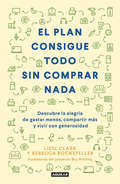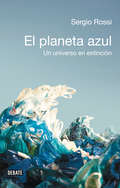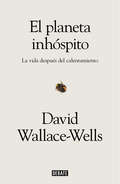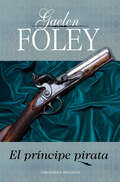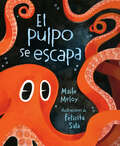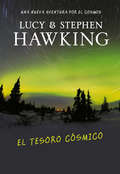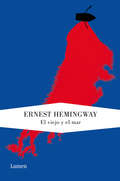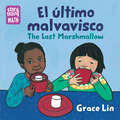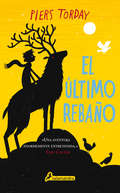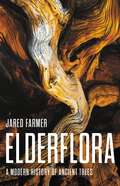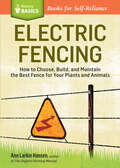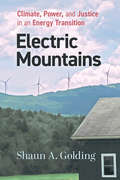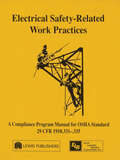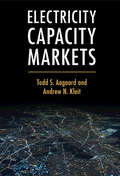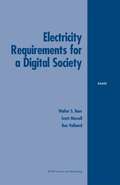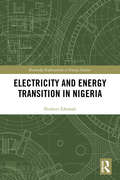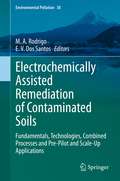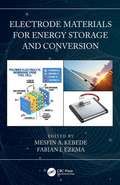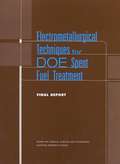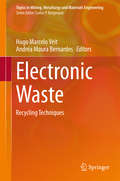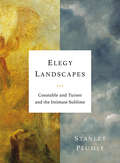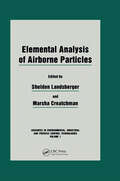- Table View
- List View
El plan consigue todo sin comprar nada: Descubre la alegría de gastar menos, compartir más y vivir con generosidad
by Liesl ClarkDescubre la verdadera libertad y felicidad que viene de comprar menos y compartir más. En 2013, las amigas Liesl Clark y Rebecca Rockefeller se dieron cuenta de la cantidad de residuos que había en sus playas locales -desde plumas y popotes hasta juguetes y cepillos de dientes- y decidieron hacer algo al respecto. Así nació el proyecto Buy Nothing. Lo que comenzó como un grupo experimental e hiperlocal de vecinos que compartían y juntaban recursos, se convirtió en un movimiento social viral de más de un millón de miembros. Inspirado en las economías de regalo tradicionales, este libro revela una nueva y liberadora forma de vida. Su programa de siete pasos con conciencia medioambiental te ayudará a convertir tu desorden en un tesoro, a pasar menos tiempo comprando y más tiempo conectando y a dejar de lado la necesidad de comprar cosas nuevas. Lleno de listas útiles, como 50 artículos que nunca necesitas comprar (bolsas herméticas y toallas de papel) o 50 cosas para hacer (limpiadores domésticos y aderezos para ensaladas), El plan consigue todo sin comprar nada te anima a repensar las compras y a adoptar una mentalidad de ahorro de espacio, dinero y tiempo.
El planeta azul
by Sergio RossiLos océanos constituyen el mayor conjunto de ecosistemas de nuestro planeta y a la vez el más desconocido puesto que no es el ambiente natural del ser humano y es difícil penetrar en él. Los mares que hoy contemplamos poco tienen que ver con los de siglos atrás: la mala praxis del hombre, las consecuencias de la pesca industrial, los problemas derivados de la contaminación y el cambio climático han afectado a nuestras aguas provocando la extinción de muchas especies y la ruptura del equilibrio marino.En El planeta azul Sergio Rossi alerta sobre los problemas que amenazan la existencia de nuestros mares y, por lo tanto, nuestra propia existencia, y propone medidas urgentes para gestionar un entorno sostenible y recuperar el equilibrio perdido.
El planeta inhóspito: La vida después del calentamiento
by David Wallace-WellsUna vez hemos reconocido que nuestro mundo llega a su fin, ¿qué podemos hacer? Este sobrecogedor relato de cómo estamos precipitando el planeta hacia su Armagedón nos descubre amenazas inimaginables hasta en nuestras peores pesadillas. Es peor, mucho peor, de lo que imaginas. Hoy, la subida del nivel del mar es una causa de alarma generalizada entre aquellos que ya han abandonado el sueño pernicioso de que el calentamiento global es un mito. Sin embargo, no es ni siquiera la punta del gigantesco iceberg de horrores inimaginables que amenazan la vida en la Tierra: incendios, huracanes, sequías, inundaciones... Todas estas inquietantes manifestaciones del cambio climático, ya recurrentes para millones de personas, son solo un adelanto de lo que está por llegar: hambrunas, plagas, un aire irrespirable, migraciones cada vez más masivas, el colapso económico e incluso conflictos armados globales. Con una precisión y una lucidez que estremecen, David Wallace-Wells construye el relato caleidoscópico de las consecuencias que tendrá, tan solo dentro de una generación, nuestra impasibilidad ante la crisis ecológica. Incidiendo con crudeza en cómo hemos fracasado al imaginar y, ante todo, promulgar un mejor porvenir, El planeta inhóspito nos transporta a un futuro inminente y nos sirve la reflexión definitiva de cómo hemos devastado nuestro propio hogar; todo ello en clave de una ferviente y aún más apremiante llamada al cambio. Reseñas:«Un antes y un después en todo lo que se ha escrito del cambio climático.»Carlos Fresneda, El Mundo «Un libro que tenemos que leer si no queremos que nuestros nietos nos maldigan.»Timothy Snyder «Un libro penetrante, que a la vez me da miedo y esperanza sobre el futuro.»Jonathan Safran Foer «David Wallace-Wells ha generado intencionadamente una sobrecogedora polémica, a caballo entre los estilos de Stephen King y Stephen Hawking. Este libro te coge totalmente desprevenido y te ahoga en un río desbordante de prosa increíblemente lírica que te convence de la inminencia del Armagedón. Vehemente y perspicaz, describe los horrores de la extinción de nuestra especie con un entusiasmo escalofriante y llega a nuestras manos justo en el momento de mayor urgencia. Espero que todo el mundo lo lea y sienta pavor.»Andrew Solomon «David Wallace-Wells sostiene que el impacto del cambio climático será mucho más grave de lo que piensa la gente, y está en lo cierto. Una obra tan oportuna como estimulante.»Elisabeth Kolbert «Fascinante, terrorífico, propicia una lectura frenética. Este libro es posiblemente el testigo más completo hasta la fecha sobre cómo el cambio climático va a transformar todos y cada uno de los aspectos de nuestras vidas, desde donde vivimos hasta lo que comemos, pasando por las historias que contamos. De obligada lectura para comprender un mundo que cada vez nos es más extraño e impredecible.»Amitav Gosh «Es un libro que tenemos que leer si no queremos que nuestros nietos nos maldigan.»Timothy Snyder «Una advertencia: cuando los científicos concluyen que el peor de los casos previstos para el calentamiento global no era más que optimismo injustificado, quizás es hora de alarmarse. Al menos, esa fue mi reacción cuando terminé de leer este brillante e implacable análisis de Wallace-Wells sobre una pesadilla que nos acecha, pues no se enmarca en un futuro lejano, sino en un presente caótico y apremiante.»Mike Davis «Una descripción rigurosa y lúcida de una crisis sin precedentes y de los mecanismos de negación a los que recurrimos para evitar reconocer su preocupante e innegable existencia.»William Gibson «El planeta inhóspito es el libro más terrorífico que
El poderoso Misisipi (¡Arriba la Lectura!. Level I #8)
by Patricia KummerEl Misisipi es un río poderoso. Lee este libro para saber más. NIMAC-sourced textbook
El poderoso roble (¡Arriba la Lectura!, Level J #1)
by Lisa Trumbauer Vicki JacobsonNIMAC-sourced textbook
El príncipe pirata (Los príncipes del mar #Volumen 1)
by Gaelen FoleyPrimera entrega de la apasionante saga de romance histórico «Los príncipes del mar». Una noche, el príncipe Lazar di Fiori regresa a la isla de Ascensión para vengar la muerte de su familia y la usurpación de su reino. Allegra Monteverdi, la hija de su enemigo, demuestra ser una valiente adversaria y le implora para que no mate a su familia. Su belleza y valor impresionan a Lazar, por lo que accede a perdonarles la vida a condición de que se convierta en su prisionera.Sola en el mar, confundida entre el miedo y la seducción, Allegra descubre que el misterioso y vengativo hombre es el príncipe Lazar, aquél con el que soñaba cuando era niña. Pero hará falta mucho más que su creciente amor para conseguir que el príncipe pirata se enfrente a los fantasmas del pasado y consiga apaciguar su atormentado corazón.
El pulpo se escapa
by Maile MeloyDe una autora best seller del New York Times surge este conmovedor y lírico relato sobre el gran artista del escape en la naturaleza, perfecto para los fanáticos del documental ganador del Oscar My Octopus Teacher. El pulpo vivía feliz en su cueva submarina hasta que un día, un buzo lo captura y lo lleva a vivir a un acuario. Los humanos le dan comida y le ponen pruebas que parecen juguetes. Pero todos los días son iguales, y el pulpo pronto se cansa de la vida cautiva. Y así, al amparo de la oscuridad, emprende un escape audaz. Maile Meloy y Felicita Sala nos traen una historia llena de emoción y sentimiento, sobre la exaltación de conquistar la libertad con tanto esfuerzo y el llamado del hogar.
El tesoro cósmico: Una nueva aventura por el cosmos (La clave secreta del universo #Volumen 2)
by Stephen Hawking Lucy HawkingDespués del rotundo éxito en todo el mundo con su primera entrega de la guía para conocer el Universo, el prestigioso científico Stephen Hawking y su hija Lucy, acercan de forma divertida y amena la ciencia a los jóvenes de la casa. Algo no marcha bien. Eric, el antiguo vecino de George, está en Florida trabajando en un proyecto científico para descubrir si hay vida en el planeta Marte y en otros lugares del Sistema Solar. El robot encargado de la misión actúa de forma muy extraña y, según le cuenta Annie a George, ¡un alien les ha enviado un mensaje para decirles que deben volver al espacio si no quieren que el mundo se acabe! Una vez más, Annie y George deberán enfundarse sus trajes espaciales y seguir las pistas que les conducirán hasta un peligrosísimo y siniestro personaje... Reseña:«Por fin una ayuda extra para los padres poco dados en materia de ciencia.»New York Magazine
El viejo y el mar: Prólogo Con Reseña Crítica De La Obra, Vida Y Obra Del Autor, Y Marco Histórico (Estudio Literario Ser. #Vol. 361)
by Ernest HemingwayUna de las historias más grandes jamás contadas. En esta nueva y magistral traducción de Miguel Temprano García, El viejo y el mar recobra todo el esplendor del clásico imperecedero que le valió el Premio Pulitzer de 1953 a Ernest Hemingway. Con un lenguaje de gran fuerza y sencillez, El viejo y el mar narra la historia de un viejo pescador cubano a quien la suerte parece haber abandonado, y del desafío mayúsculo al que se enfrenta: la batalla despiadada y sin tregua con un pez gigantesco en las aguas del golfo. Escrito en 1952, por encargo de la revista Life, este relato lo confirmó como uno de los escritores más significativos del siglo XX, obteniendo el Premio Pulitzer en 1953 y allanando su carrera hacia el Nobel de Literatura, que recibió en 1954. Reseña:«Su mejor obra. El tiempo demostrará que es la mejor que cualquiera de nosotros haya escrito, y con eso me refiero a sus coetáneos y a los míos.»William Faulkner
El último malvavisco / The Last Marshmallow (Storytelling Math)
by Grace LinNow in Spanish bilingual editions--Caldecott Honor winner Grace Lin celebrates math for every kid in this board book series.After playing in the snow, Olivia and Mei are ready for cocoa. There's one marshmallow for Olivia and one marshmallow for Mei. But what will they do with the third marshmallow? How can two friends share three things fairly?The Storytelling Math series shows that all children can be mathematical thinkers. Each book includes ideas for exploring math at home with your children, developed in collaboration with math experts at STEM education nonprofit TERC Inc., under a grant from the Heising-Simons Foundation.
El último rebaño
by Piers TordayUna novela maravillosa galardonada con el Guardian Children's Fiction Prize. Ésta es la historia de un niño llamado Kester. Es un niño muy especial, aunque él aún lo ignora. Ahora mismo, lo único que sabe es esto:1. En su habitación hay una bandada de palomas alborotadas.2. Le están hablando.3. Su vida nunca volverá a ser como antes... Críticas:«Una novela escrita con un estilo muy gráfico y trepidante [...]. Muy recomendable.»The Times «Ingeniosa, llena de risas, lágrimas y suspense.»The Sunday Times «Me ha entusiasmado.»The Guardian «Más vale que la segunda entrega llegue pronto.»The Observer «Un libro maravillosamente extraño y extrañamente maravilloso.»Financial Times
Elderflora: A Modern History of Ancient Trees
by Jared FarmerThe epic story of the planet&’s oldest trees and the making of the modern world Humans have always revered long-lived trees. But as historian Jared Farmer reveals in Elderflora, our veneration took a modern turn in the eighteenth century, when naturalists embarked on a quest to locate and precisely date the oldest living things on earth. The new science of tree time prompted travelers to visit ancient specimens and conservationists to protect sacred groves. Exploitation accompanied sanctification, as old-growth forests succumbed to imperial expansion and the industrial revolution. Taking us from Lebanon to New Zealand to California, Farmer surveys the complex history of the world&’s oldest trees, including voices of Indigenous peoples, religious figures, and contemporary scientists who study elderflora in crisis. In a changing climate, a long future is still possible, Farmer shows, but only if we give care to young things that might grow old.
Electric Fencing: How to Choose, Build, and Maintain the Best Fence for Your Plants and Animals. A Storey BASICS® Title (Storey Basics)
by Ann Larkin HansenProtect your livestock and gardens with electric fencing. In this Storey BASICS® guide, Ann Larkin Hansen describes the pros and cons of different varieties of electric fencing so that you can choose the fence that best suits your property and needs. You’ll also learn how electric fencing works and how to put it together yourself. Whether you’re looking for a standard design to reign in your flock or a portable version for rotational grazing, this accessible volume will help you find an efficient, cost-effective solution.
Electric Mountains: Climate, Power, and Justice in an Energy Transition (Nature, Society, and Culture)
by Shaun A. GoldingClimate change has shifted from future menace to current event. As eco-conscious electricity consumers, we want to do our part in weening from fossil fuels, but what are we actually a part of? Committed environmentalists in one of North America’s most progressive regions desperately wanted energy policies that address the climate crisis. For many of them, wind turbines on Northern New England’s iconic ridgelines symbolize the energy transition that they have long hoped to see. For others, however, ridgeline wind takes on a very different meaning. When weighing its costs and benefits locally and globally, some wind opponents now see the graceful structures as symbols of corrupted energy politics. This book derives from several years of research to make sense of how wind turbines have so starkly split a community of environmentalists, as well as several communities. In doing so, it casts a critical light on the roadmap for energy transition that Northern New England’s ridgeline wind projects demarcate. It outlines how ridgeline wind conforms to antiquated social structures propping up corporate energy interests, to the detriment of the swift de-carbonizing and equitable transformation that climate predictions warrant. It suggests, therefore, that the energy transition of which most of us are a part, is probably not the transition we would have designed ourselves, if we had been asked.
Electrical Safety-Related Work Practices: OSHA Manual
by Richard EnnisElectrical Safety-Related Work Practices is a complete training package that describes 29 CFR 1910.331-.335, OSHA's Electrical Safety-Related Practices Standard, and outlines the requirements for training employees exposed to electrical hazards. The program presents a thorough overview of electrical safety as it applies to the standard. Topics covered include electrical accidents, qualified and unqualified persons, employee training, work practices covered by the standard, protective equipment, and protective shields and barriers. A complete implementation plan, standard checklists, a summary of the standard, and a copy of OSHA's "Illustrated Guide to Electrical Safety" are provided in addition to a sample employee training booklet. Electrical Safety-Related Work Practices is the perfect training tool for risk managers, safety managers, line production supervisors, engineers, and maintenance workers affected by this OSHA standard.This complete training package contains implementation/compliance manual, VHS tape, employee training booklet.
Electricity Capacity Markets
by Andrew N. Kleit Todd S. AagaardInitially created as afterthoughts to competitive electricity markets, capacity markets were intended to enhance system reliability. They have evolved into massive, highly controversial, and poorly understood billion-dollar institutions. Electricity Capacity Markets examines the rationales for creating capacity markets, how capacity markets work, and how well these markets are meeting their objectives. This book will appeal to energy experts and non-experts alike, across a range of disciplines, including economics, business, engineering, public policy, and law. Capacity markets are an important and provocative topic on their own, but they also offer an interesting case study of how well our energy systems are meeting the needs of our increasingly complex society. The challenges facing capacity markets – harnessing market forces for social good, creating networks that manage complexity, and achieving sustainability – are very much core challenges for our twenty-first century advanced industrial society.
Electricity Requirements for a Digital Society
by Scott Hassell Ben A. Vollaard Walter S. BaerGreater use of information and communications technologies (ICTs) marks a U.S. transition toward a "digital society" that may profoundly affect electricity supply, demand, and delivery. RAND developed four 2001-2021 scenarios of ICT evolution and assessed their implications for U.S. electricity requirements. Even large deployment of ICTs will only modestly increase U.S. electricity use over the next two decades. The more pressing concern will be how to meet the increased need for higher-quality and more-reliable power that accompanies ICT use.
Electricity and Energy Transition in Nigeria (Routledge Explorations in Energy Studies)
by Norbert EdomahElectricity and Energy Transition in Nigeria provides readers with a detailed account of the dynamics of energy infrastructure change in Nigeria’s electricity sector. The book starts by introducing the basic theories underpinning the politics of energy infrastructure supply and goes on to explore the historical dimensions of the Nigerian energy transition by highlighting the influences and drivers of energy systems change. Edomah also examines the political dynamics at play, highlighting the political actors and institutions that shape energy supply, as well as the impact of consumer politics. The book concludes by considering how all these factors may influence the future of energy in Nigeria. This book will be of great interest to students and scholars of energy transitions, energy technology and infrastructure, and African Studies more generally.
Electrochemically Assisted Remediation of Contaminated Soils: Fundamentals, Technologies, Combined Processes and Pre-Pilot and Scale-Up Applications (Environmental Pollution #30)
by M. A. Rodrigo E. V. Dos SantosThis book provides an overview of the current development status of remediation technologies involving electrochemical processes, which are used to clean up soils that are contaminated with different types of contaminants (organics, inorganics, metalloids and radioactive). Written by internationally recognized experts, it comprises 21 chapters describing the characteristics and theoretical foundations of various electrochemical applications of soil remediation. The book’s opening section discusses the fundamental properties and characteristics of the soil, which are essential to understand the processes that can most effectively remove organic and inorganic compounds. This part also focuses on the primary processes that contribute to the application of electrochemically assisted remediation, hydrodynamic aspects and kinetics of contaminants in the soil. It also reviews the techniques that have been developed for the treatment of contaminated soils using electrochemistry, and discusses different strategies used to enhance performance, the type of electrode and electrolyte, and the most important operating conditions. In turn, the book’s second part deals with practical applications of technologies related to the separation of pollutants from soil. Special emphasis is given to the characteristics of these technologies regarding transport of the contaminants and soil toxicity after treatment. The third part is dedicated to new technologies, including electrokinetic remediation and hybrid approaches, for the treatment of emerging contaminants by ex-situ and in-situ production of strong oxidant species used for soil remediation. It also discusses pre-pilot scale for soil treatment and the use of solar photovoltaic panels as an energy source for powering electrochemical systems, which can reduce both the investment and maintenance costs of electrochemically assisted processes.
Electrode Materials for Energy Storage and Conversion
by Mesfin A. KebedeThis book provides a comprehensive overview of the latest developments and materials used in electrochemical energy storage and conversion devices, including lithium-ion batteries, sodium-ion batteries, zinc-ion batteries, supercapacitors and conversion materials for solar and fuel cells. Chapters introduce the technologies behind each material, in addition to the fundamental principles of the devices, and their wider impact and contribution to the field. This book will be an ideal reference for researchers and individuals working in industries based on energy storage and conversion technologies across physics, chemistry and engineering. FEATURES Edited by established authorities, with chapter contributions from subject-area specialists Provides a comprehensive review of the field Up to date with the latest developments and research Editors Dr. Mesfin A. Kebede obtained his PhD in Metallurgical Engineering from Inha University, South Korea. He is now a principal research scientist at Energy Centre of Council for Scientific and Industrial Research (CSIR), South Africa. He was previously an assistant professor in the Department of Applied Physics and Materials Science at Hawassa University, Ethiopia. His extensive research experience covers the use of electrode materials for energy storage and energy conversion. Prof. Fabian I. Ezema is a professor at the University of Nigeria, Nsukka. He obtained his PhD in Physics and Astronomy from University of Nigeria, Nsukka. His research focuses on several areas of materials science with an emphasis on energy applications, specifically electrode materials for energy conversion and storage.
Electrometallurgical Techniques for DOE Spent Fuel Treatment: FINAL REPORT
by Committee on Electrometallurgical Techniques for DOE Spent Fuel TreatmentThe National Academies Press (NAP)--publisher for the National Academies--publishes more than 200 books a year offering the most authoritative views, definitive information, and groundbreaking recommendations on a wide range of topics in science, engineering, and health. Our books are unique in that they are authored by the nation's leading experts in every scientific field.
Electronic Waste
by Hugo Marcelo Veit Andréa Moura BernardesThis book presents an overview of the characterization of electronic waste. In addition, processing techniques for the recovery of metals, polymers and ceramics are described. This book serves as a source of information and as an educational technical reference for practicing scientists and engineers, as well as for students.
Elegy Landscapes: Constable And Turner And The Intimate Sublime
by Stanley PlumlyA sweeping look at the lives and work of two important English Romantic painters, from a Los Angeles Times Book Prize–winning author. Renowned poet Stanley Plumly, who has been praised for his “obsessive, intricate, intimate and brilliant” (Washington Post) nonfiction, explores immortality in art through the work of two impressive landscape artists: John Constable and J.M.W. Turner. How is it that this disparate pair will come to be regarded as Britain’s supreme landscape painters, precursors to Impressionism and Modernism? How did each painter’s life influence his work? Almost exact contemporaries, both legendary artists experience a life-changing tragedy—for Constable it is the long illness and death of his wife; for Turner, the death of his singular parent and supporter, his father. Their work will take on new power thereafter: Constable, his Hampstead cloud studies; Turner, his Venetian watercolors and oils. Seeking the transcendent aesthetic awe of the sublime and reeling from their personal anguish, these talented painters portrayed the terrible beauty of the natural world from an intimate, close-up perspective. Plumly studies the paintings against the pull of the artists’ lives, probing how each finds the sublime in different, though inherently connected, worlds. At once a meditation on the difficulties in achieving truly immortal works of art and an exploration of the relationship between artist and artwork, Elegy Landscapes takes a wide-angle look at the philosophy of the sublime.
Elemental Analysis of Airborne Particles
by Sheldon Landsberger Marsha CreatchmanAn increased standard of living in developed and developing countries has brought about a distinct rise in pollution. The problem of air pollution has specifically increased the public's awareness of the environmental and health-related consequences resulting from modern day industrial technology. This detailed collection of works devoted to the most popular methods in elemental analysis of airborne particles offers investigators a comprehensive book on the most common laboratory analytical methods currently used in trace element analysis. Discussed are atomic absorption spectrometry, inductively coupled plasma, atomic emission, particle induced gamma ray analysis, particle elastic scattering and Rutherford backscattering, and neutron activation analysis. Specific sections on quality assurance/quality control and source receptor modeling have also been included.
